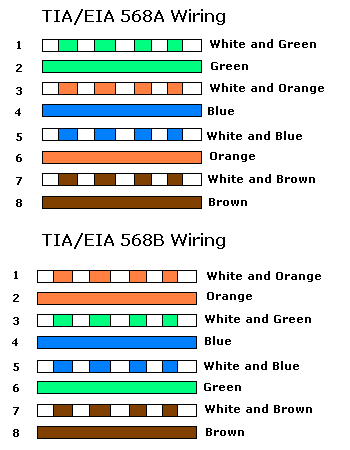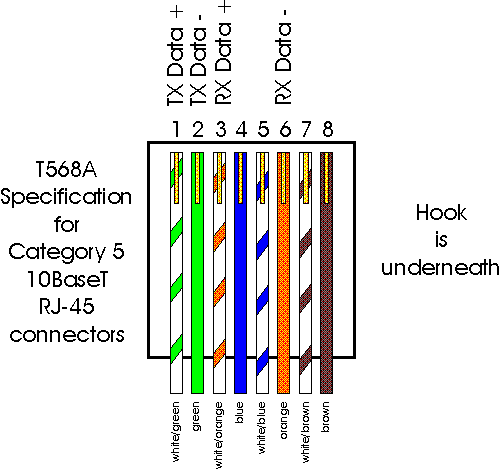I'm an electrician who is applying for a job where some knowledge of CAT 5 networking would be helpful, but not essential. I jst would like to get some tips, like how are the cores identified, and how they are normally terminated?
You are using an out of date browser. It may not display this or other websites correctly.
You should upgrade or use an alternative browser.
You should upgrade or use an alternative browser.
CAT 5 Cable Cores
- Thread starter DRL
- Start date
Sponsored Links
A cat5 cable is designed to the BT standards regarding colour.
Cable core
1= White with blue
2= Blue with white
3= White with orange
4= Orange with white
5= White with green
6= Green with white
7= White with brown
8= Brown with white
Industry standard termination is via IDC (insulation displacement connection) otherwise referred to as a Krone connection requiring a krone tool.
Nearly every cat 5 / 5e / 6 /7 manufacture uses IDC, the big exception is ATT / Lucent 110 which (due to US design) uses a different IDC technique and unique patching.
In general Cat 5 should not be run for lengths longer than 90m + patching / flyleads at either end
Cat 5 cable have numbers along the sheath, this numbers are measurements. Say 10008 at end of cable and 10110 at beginning, you now know the cable box (or cable run) is 10110-10008 or 102. The measurement COULD be either feet or metres depending on make.
Basic Cat 5 test tool will check all 8 connections, the best at about £90 is a mod tap tester.
A warranted Cat5 system needs to use a full range tester for attenuation, pin mix, Db, length and various other tests. These testers cost £1600+ (all the way to £6k )
)
All Cat 5 is star wired from a comms cabinet to each user. Most users have 3 Cat 5 outlets (PC, Printer, Voice)
Where a building cannot be wired from a single central location due to the 90m length rule it is common to have a comms sub closet on each floor or even each wing on a floor. These sub closets link local wiring within the 90m to IP Data hubs / switches in the sub closet. these in turn are linked back to the main comms / data room via single mode ST connected fibre cables or even Cat 5 if the distance is less than 90m and the 100 Mb speed of Cat 5 is band width capable.
Hope that helps
Cable core
1= White with blue
2= Blue with white
3= White with orange
4= Orange with white
5= White with green
6= Green with white
7= White with brown
8= Brown with white
Industry standard termination is via IDC (insulation displacement connection) otherwise referred to as a Krone connection requiring a krone tool.
Nearly every cat 5 / 5e / 6 /7 manufacture uses IDC, the big exception is ATT / Lucent 110 which (due to US design) uses a different IDC technique and unique patching.
In general Cat 5 should not be run for lengths longer than 90m + patching / flyleads at either end
Cat 5 cable have numbers along the sheath, this numbers are measurements. Say 10008 at end of cable and 10110 at beginning, you now know the cable box (or cable run) is 10110-10008 or 102. The measurement COULD be either feet or metres depending on make.
Basic Cat 5 test tool will check all 8 connections, the best at about £90 is a mod tap tester.
A warranted Cat5 system needs to use a full range tester for attenuation, pin mix, Db, length and various other tests. These testers cost £1600+ (all the way to £6k
All Cat 5 is star wired from a comms cabinet to each user. Most users have 3 Cat 5 outlets (PC, Printer, Voice)
Where a building cannot be wired from a single central location due to the 90m length rule it is common to have a comms sub closet on each floor or even each wing on a floor. These sub closets link local wiring within the 90m to IP Data hubs / switches in the sub closet. these in turn are linked back to the main comms / data room via single mode ST connected fibre cables or even Cat 5 if the distance is less than 90m and the 100 Mb speed of Cat 5 is band width capable.
Hope that helps
The twisted pairs do NOT all use adjacent pins in the sockets
Typically the orange and brown pair do but the green and blue pair are intermingled
http://www.netspec.com/helpdesk/wiredoc.html
Typically the orange and brown pair do but the green and blue pair are intermingled
http://www.netspec.com/helpdesk/wiredoc.html
Sponsored Links
Chri5 said:Didn't say they did, did I??
No you didn't, but I know a man who without being told otherwise assumed they did.
So I thought I would mention it just in case
Thanks everyone, that has been very helpful. It all should give me a good background to start with.
Chris
May I hi-jack that diagram, it make it very clear. The "hook underneath" explanation is so clear and better than the sketches of hook and wire.
Regards
Bernard
May I hi-jack that diagram, it make it very clear. The "hook underneath" explanation is so clear and better than the sketches of hook and wire.
Regards
Bernard
- Joined
- 11 Jan 2004
- Messages
- 42,851
- Reaction score
- 2,661
- Country

DRL, if you are going to get a krone tool the good ones cost around £25 but be aware of cheap imitations from far east countrys,also another tip is if you are running dont be tempted to run them with any conduit/trays that have electric cables in as any dsl curcuit can pick up induction and create problems with dsl connection dropping out
maybe you were but your post didn't make that entirely clear, if i'd come along with no previous knowlage i'd have probablly assumed that the numbers you gave were pin numbers.Chri5 said:Didn't say they did, did I?? I was referencing the ID of core, not terminations! As in 4 pair / 8 wires 1st wire, 2nd etc
note, some gigabit ethernet cards can do theese kind of tests on the cable they are connected to.Chri5 said:Basic Cat 5 test tool will check all 8 connections, the best at about £90 is a mod tap tester.
A warranted Cat5 system needs to use a full range tester for attenuation, pin mix, Db, length and various other tests. These testers cost £1600+ (all the way to £6k)
the traditional approach to installation though has always been if ethernet works then it must be acceptable
a few more notes,
if you are desperate you can run multiple things down one cat5 cable, 100 megabit and slower speeds of ethernet requires 2 pairs as does phone after master (you can do two phone lines after master in 3 pairs but it can cause crosstalk). I wouldn't reccomend doing this for a new installation though.
btw using cat5 cable for DSL is pretty pointless and may actually make things worse. You are probablly better off using BT spec phone cable.
if you are desperate you can run multiple things down one cat5 cable, 100 megabit and slower speeds of ethernet requires 2 pairs as does phone after master (you can do two phone lines after master in 3 pairs but it can cause crosstalk). I wouldn't reccomend doing this for a new installation though.
btw using cat5 cable for DSL is pretty pointless and may actually make things worse. You are probablly better off using BT spec phone cable.
plugwash said:the traditional approach to installation though has always been if ethernet works then it must be acceptable
I can accept that on small instals the above might be true, but commercial Cat 5/6 systems of more that a few double or quad outlets will need testing with a Pentasanner or similar.
Having wired sites as foreman and project designer, any business seeking value for £50 per point x 100+ points will require a system warranty. Most will certify 15 year performance at whatever the speed the system is designed for, cat 5 being 100b T or 100 Mbits per second.
Full testing for:-
Measures cable length and distances to opens and shorts
Tests continuity, proper termination and polarity
Tests shielded or unshielded CAT3, CAT5, CAT5e & CAT6
Wiremaps individual runs to locate and identify cable routes
Tests interconnect specifications per TIA 568/570, including opens, shorts, miswires, split pairs, etc.
Cable Quality Tests
SKEW
NEXT-All combinations on all pairs (12)
Channel Response
Echo Testing (Return Loss) impedance mismatches
Signal to Noise Ratio
Attenuation
Amplitude
Return Loss
Bit Error Rate (BERT)
Signal quality in actual link environments that could account for cable inadequacies, such as physical installation problems, kinks, loops, physical terminations, dry shorts, or miswires.
All Cat 5 systems should be tested, end off. for very small, short run work then a modtap pin check is the absolute basics. For any commercial site requiring a protection on the investment, warranty and thus certified full testing is manditory.
DIYnot Local
Staff member
If you need to find a tradesperson to get your job done, please try our local search below, or if you are doing it yourself you can find suppliers local to you.
Select the supplier or trade you require, enter your location to begin your search.
Please select a service and enter a location to continue...
Are you a trade or supplier? You can create your listing free at DIYnot Local
Sponsored Links
Similar threads
- Replies
- 4
- Views
- 1K
- Replies
- 16
- Views
- 3K



